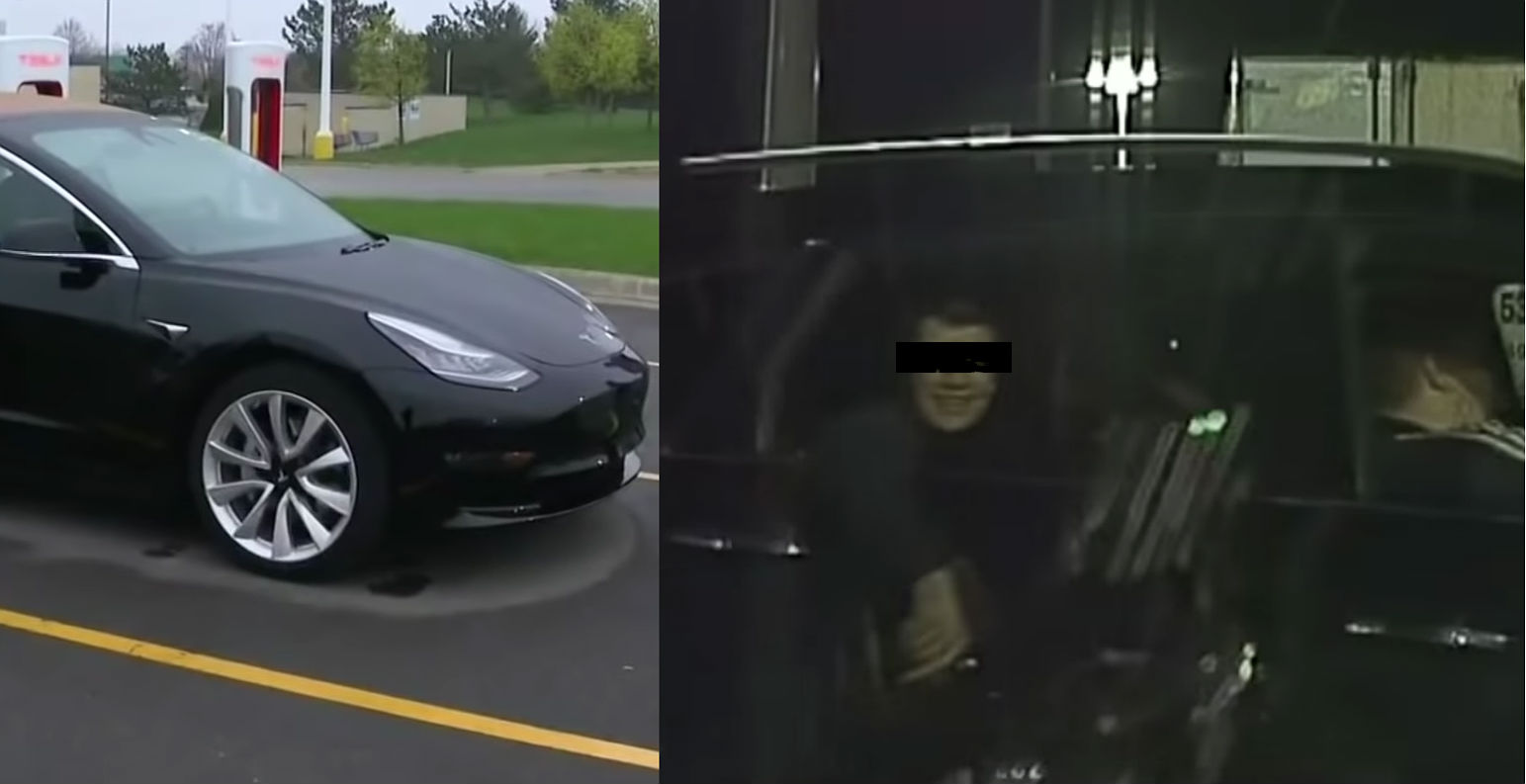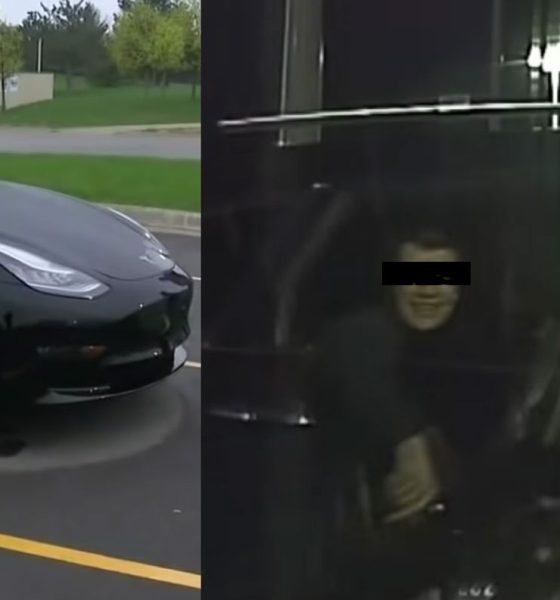

News
Tesla dashcam catches teens egging Model 3 at Supercharger
A Tesla owner is thanking his Model 3’s built-in dashcam features for capturing footage of a group of teenagers vandalizing his electric car. When he reported the incident to local authorities, the Model 3 owner was surprised to learn that his vehicle might not be the first Tesla to be vandalized in the location.
Darin Lee, the Model 3 owner, was Supercharging his electric sedan at a Supercharger in a Meijer outlet in Ann Arbor, MI, when a group of teenagers in a Cadillac SUV pulled up to his vehicle. Laughing amongst themselves, the vandals proceeded to pelt the Model 3 with several eggs.
Lee was inside the vehicle then, and when the teens realized that there was someone inside the Model 3, they promptly drove off. “I think they were going to cover my car with all five-dozen eggs. They saw me and took off real quick,” Lee said, speaking to local news.
What the teens didn’t know was that the Tesla was actively recording its surroundings while it was Supercharging. Thus, everything, from the moment they pulled up to the vehicle to the point where they realized the owner was inside the electric car, everything was captured in all their embarrassing glory.
While the incident seemed to be a simple prank, Lee notes that it might end up costing him a significant amount. Speaking to local news, the Model 3 owner noted that his electric car’s paint actually got scratches from the incident, which might cost him as much as $800 to repair.
Lee later reported the incident and turned over his Model 3’s dashcam footage to the police. Surprisingly, the police notified Lee that his Model 3 might not be the first Tesla to be vandalized in the same Supercharger. “It’s terrible, what’s happened. Just for you know, driving a specific car. If that is what it is,” Lee said.
The Model 3 owner noted that he bought his electric car primarily to help his disabled roommate get around. For now, Lee hopes that the teens behind the incident could be identified, especially since the vandalism, even if it’s just a prank, could be a costly one.
Fortunately, the teens behind the vandalism of the Model 3 have not been very smart about their prank. The teens, for example, seemed to have bought the eggs at the Meijer outlet nearby, where surveillance cameras recorded them. The store hopes to turn their surveillance footage over to the police as well.
Tesla has made a reputation for being one of the few carmakers that improve its vehicles over time through free over-the-air updates. The Model 3’s built-in dashcam feature, as well as the more robust Sentry Mode anti-theft system, are among these improvements. Hopefully, the dashcam footage from Darin Lee’s Model 3 could indeed be used to crack open the case and serve justice… sunny side down.
Tesla’s electric cars are well-loved vehicles, but they remain polarizing for a select group of people, particularly those who are not open to the idea of electric propulsion replacing the internal combustion engine. This has resulted in incidents such as ICE-ing, which involves preventing an electric car from charging, and even attacks on Superchargers.
Watch a segment on the vandalism of a Tesla Model 3 in the video below.

News
Tesla FSD fleet is nearing 7 billion total miles, including 2.5 billion city miles
As can be seen on Tesla’s official FSD webpage, vehicles equipped with the system have now navigated over 6.99 billion miles.

Tesla’s Full Self-Driving (Supervised) fleet is closing in on almost 7 billion total miles driven, as per data posted by the company on its official FSD webpage.
These figures hint at the massive scale of data fueling Tesla’s rapid FSD improvements, which have been quite notable as of late.
FSD mileage milestones
As can be seen on Tesla’s official FSD webpage, vehicles equipped with the system have now navigated over 6.99 billion miles. Tesla owner and avid FSD tester Whole Mars Catalog also shared a screenshot indicating that from the nearly 7 billion miles traveled by the FSD fleet, more than 2.5 billion miles were driven inside cities.
City miles are particularly valuable for complex urban scenarios like unprotected turns, pedestrian interactions, and traffic lights. This is also the difference-maker for FSD, as only complex solutions, such as Waymo’s self-driving taxis, operate similarly on inner-city streets. And even then, incidents such as the San Francisco blackouts have proven challenging for sensor-rich vehicles like Waymos.
Tesla’s data edge
Tesla has a number of advantages in the autonomous vehicle sector, one of which is the size of its fleet and the number of vehicles training FSD on real-world roads. Tesla’s nearly 7 billion FSD miles then allow the company to roll out updates that make its vehicles behave like they are being driven by experienced drivers, even if they are operating on their own.
So notable are Tesla’s improvements to FSD that NVIDIA Director of Robotics Jim Fan, after experiencing FSD v14, noted that the system is the first AI that passes what he described as a “Physical Turing Test.”
“Despite knowing exactly how robot learning works, I still find it magical watching the steering wheel turn by itself. First it feels surreal, next it becomes routine. Then, like the smartphone, taking it away actively hurts. This is how humanity gets rewired and glued to god-like technologies,” Fan wrote in a post on X.
News
Tesla starts showing how FSD will change lives in Europe
Local officials tested the system on narrow country roads and were impressed by FSD’s smooth, human-like driving, with some calling the service a game-changer for everyday life in areas that are far from urban centers.

Tesla has launched Europe’s first public shuttle service using Full Self-Driving (Supervised) in the rural Eifelkreis Bitburg-Prüm region of Germany, demonstrating how the technology can restore independence and mobility for people who struggle with limited transport options.
Local officials tested the system on narrow country roads and were impressed by FSD’s smooth, human-like driving, with some calling the service a game-changer for everyday life in areas that are far from urban centers.
Officials see real impact on rural residents
Arzfeld Mayor Johannes Kuhl and District Administrator Andreas Kruppert personally tested the Tesla shuttle service. This allowed them to see just how well FSD navigated winding lanes and rural roads confidently. Kruppert said, “Autonomous driving sounds like science fiction to many, but we simply see here that it works totally well in rural regions too.” Kuhl, for his part, also noted that FSD “feels like a very experienced driver.”
The pilot complements the area’s “Citizen Bus” program, which provides on-demand rides for elderly residents who can no longer drive themselves. Tesla Europe shared a video of a demonstration of the service, highlighting how FSD gives people their freedom back, even in places where public transport is not as prevalent.
What the Ministry for Economic Affairs and Transport says
Rhineland-Palatinate’s Minister Daniela Schmitt supported the project, praising the collaboration that made this “first of its kind in Europe” possible. As per the ministry, the rural rollout for the service shows FSD’s potential beyond major cities, and it delivers tangible benefits like grocery runs, doctor visits, and social connections for isolated residents.
“Reliable and flexible mobility is especially vital in rural areas. With the launch of a shuttle service using self-driving vehicles (FSD supervised) by Tesla in the Eifelkreis Bitburg-Prüm, an innovative pilot project is now getting underway that complements local community bus services. It is the first project of its kind in Europe.
“The result is a real gain for rural mobility: greater accessibility, more flexibility and tangible benefits for everyday life. A strong signal for innovation, cooperation and future-oriented mobility beyond urban centers,” the ministry wrote in a LinkedIn post.
News
Tesla China quietly posts Robotaxi-related job listing
Tesla China is currently seeking a Low Voltage Electrical Engineer to work on circuit board design for the company’s autonomous vehicles.

Tesla has posted a new job listing in Shanghai explicitly tied to its Robotaxi program, fueling speculation that the company is preparing to launch its dedicated autonomous ride-hailing service in China.
As noted in the listing, Tesla China is currently seeking a Low Voltage Electrical Engineer to work on circuit board design for the company’s autonomous vehicles.
Robotaxi-specific role
The listing, which was shared on social media platform X by industry watcher @tslaming, suggested that Tesla China is looking to fill the role urgently. The job listing itself specifically mentions that the person hired for the role will be working on the Low Voltage Hardware team, which would design the circuit boards that would serve as the nervous system of the Robotaxi.
Key tasks for the role, as indicated in the job listing, include collaboration with PCB layout, firmware, mechanical, program management, and validation teams, among other responsibilities. The role is based in Shanghai.
China Robotaxi launch
China represents a massive potential market for robotaxis, with its dense urban centers and supportive policies in select cities. Tesla has limited permission to roll out FSD in the country, though despite this, its vehicles have been hailed as among the best in the market when it comes to autonomous features. So far, at least, it appears that China supports Tesla’s FSD and Robotaxi rollout.
This was hinted at in November, when Tesla brought the Cybercab to the 8th China International Import Expo (CIIE) in Shanghai, marking the first time that the autonomous two-seater was brought to the Asia-Pacific region. The vehicle, despite not having a release date in China, received a significant amount of interest among the event’s attendees.








